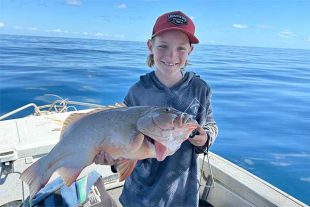TO help protect Queensland’s beautiful natural waterways for generations to come, fishers must not move raw prawns, yabbies and marine worms out of the white spot disease movement restriction area in southeast Queensland.
The movement restrictions are in place from Caloundra to the NSW border and west to Ipswich. While we know prawns swim and could spread the disease as they move around, the most likely way the disease will spread long distances is by people moving raw prawns, yabbies or worms and then using them as bait. The movement restrictions in place also apply to uncooked, frozen crustaceans as freezing does not destroy the virus.
What is white spot disease?
White spot disease is caused by a virus that affects crustaceans such as prawns, crabs, lobsters and yabbies. The disease was first detected in prawn farms along the Logan River south of Brisbane in December 2016. It was then found in prawn and crab samples collected from the Logan River, Brisbane River, Moreton Bay and Deception Bay.
When found in high-intensity production areas, such as prawn farms, white spot disease results in the rapid mortality of prawns.
While white spot disease does not affect fish, it is not known what impacts the disease could have on the marine food chain and local fish stocks. Prawns infected with white spot disease do not pose a risk to people’s health and are completely safe.
What is being done to stop the disease?
Biosecurity Queensland is focused on eradicating white spot disease from Australia. All infected prawn farms in southeast Queensland where the disease was first found have been decontaminated and extensive surveillance is being undertaken across the state looking for the virus that causes the disease.
Since the initial detection of white spot disease in the Moreton Bay region in December 2016, more than 50,000 prawn and crab samples have been tested for the virus. During the latest round of testing, completed in September 2017, all samples collected from the Moreton Bay region and key locations along the Queensland coastline have returned negative results for the virus that causes white spot disease.
These results are encouraging and indicate the disease may not be established in Moreton Bay and has not spread into other parts of Queensland. Two years of consecutively negative test results are required to prove the disease is no longer in Australian waterways. During this time, it is crucial movement restrictions are kept in place to ensure if the virus is present, it isn’t accidentally spread.
What does white spot disease look like?
Prawns with white spot disease may have a loose shell with numerous white spots on the inside surface of the shell and a pink to red discolouration. However, please note infected prawns and yabbies might not display any symptoms and white spots may appear for a range of reasons including freezer burn and bacterial and fungal infections.
For more information on white spot disease, visit daf.qld.gov.au/WSD
 Bush ‘n Beach Fishing Magazine Location reports & tips for fishing, boating, camping, kayaking, 4WDing in Queensland and Northern NSW
Bush ‘n Beach Fishing Magazine Location reports & tips for fishing, boating, camping, kayaking, 4WDing in Queensland and Northern NSW









